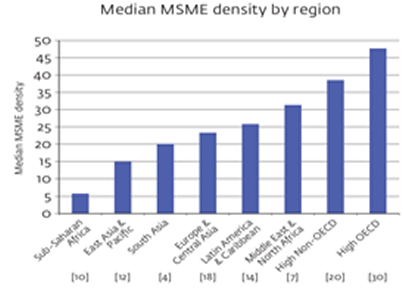Step 1. Read about the specific characteristics of SMEs and their participation in international trade
Definition of an SME
What exactly is an SME?
The definition of Small and Medium-sized Enterprises (SME) varies across countries and organizations. The most commonly used denominator for a definition is the number of employees, followed by turnover and assets (*1).
A majority of governments, namely middle income and high-income economies, the OECD and the IMF, define a SME as an enterprise employing up to 249 persons. they further divide the category into micro (1-9 employees), small (10-49 employees) and medium (50-249 employees) enterprises. Lower income economies more frequently use 50 or 100 employees as a threshold for defining an SME.
Annual turnover may also be used to define an SME (*2), with the turnover threshold for SMEs ranging between US$ 50 million to70 million (*3) in high-income economies, and between US$ 1 million and 5 million US$ in lower income developing countries.
In 2014, there were about 162.8 million formal Micro, Small and Medium-Sized Enterprises (MSMEs), employing more than 508 million employees, according to one global data set covering 155 (*4) .The number of SMEs varies significantly across regions – see Figure below.

Hhigh-income economies continue to have the highest SME density, measured as number of SMEs per 1,000 people, but it is the Central Asian and middle-income economies in Europe that have experienced the highest growth in number of SMEs in recent years.
SMEs play an important role for the national economy by generating employment, value added production and innovation. Their integration into the global economy however is uneven and “overall, SMEs tend to be under-represented in international trade”. “There are a few “born global” firms and highly innovative SMEs that are fully integrated into global markets (“small multinationals”), and a sizeable share of SMEs that export or are embedded in Global Value Chains (GVCs) as suppliers of exporters. ”
| SME contribution to trade in the U.S.A. and Argentina In Argentina, SMEs account for 99% of total firms and 64% of employment. Yet, only about 20% of industrial MSMEs are engaged in international trade. Moreover, while exporting SMEs represent 88% of all exporters, they account for only 9% of Argentina’s exports, despite making up 88% of all exports.In the U.S.A., SME’s share of known value of merchandises US exports to all destinations was 33% in 2011. The major destination markets were Canada and Mexico and 17.5% of exports by SMEs go to the EU. SMEs accounted for 30% of US merchandise exports to the EU . |
SME’s participation in international trade has the following characteristics:
- Few SMEs export and for those that trade, exports represent a lower share of turnover than for larger firms;
- Micro and small firms rarely engage in international trade (only 10-15% of them engage in trade in OECD countries);
- SMEs export disproportionally into neighboring countries and only few penetrate emerging economies (*8).
With regards to SME’s position in value chains, the ITC competitiveness Outlook 2017 (*7) stresses the fact that
- SMEs tend to be suppliers to a value chain rather than producers of a final good and are more likely to integrate into regional production networks than truly global value chains.
- Tipically SMEs join Global Value Chains or Regional production networks with low value-added production and services (*7), in particular in Africa and Latin American countries.
SMEs’ lower level of participation in global trade reflects particular challenges when accessing markets. These challenge will be discussed next.
(*1) Erick Gonzales, Martin Hommes, Melina Laura Mirmulstein (2014), MSME Country Indicators 2014. Towards a better understanding of Micro, Small and Medium Enterprises, IFC, December 2014 and (*4) page 13
(*2) The EU Commission combines the factors of headcount with either annual turnover or balance sheet in its definition of SME. See EU Recommendation 2003/361 and http://ec.europa.eu/growth/smes/business-friendly-environment/sme-definition_en
(*3) Micro, small and medium enterprise country indicators. A dataset collected by IFC and GPFI of historic dataset on number of MSME in 155 economies.
(*5) OECD (2017), Small Medium Strong. Trends in SME performance and Business Condition, page 11, OECD, Publishing, Paris
(*6) US ITC (2014) “Trade Barriers that U.S. Small and Medium-sized Enterprises Perceive as Affecting Exports to the European Union”, Investigation No 332-541. Publication 445, (ITC, March 2014)
(*7) ITC (2017), Competitiveness Outlook 2017. The region: a Door to Global trade, page 7
(*8) OECD (2017), Small Medium Strong. Trends in SME performance and Business Condition, OECD, Publishing, Paris
